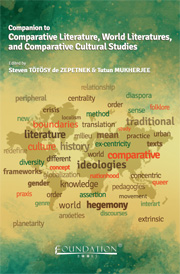Book contents
- Frontmatter
- Contents
- Introduction to the Companion to Comparative Literature, World Literatures, and Comparative Cultural Studies
- PART 1 Theories of Comparative Literature, World Literatures, and Comparative Cultural Studies
- PART 2 Comparative Literature in World Languages
- PART 3 Examples of New Work in Comparative Literature, World Literatures, and Comparative Cultural Studies
- African Literatures and Cultures and the Universal of Motherhood
- World literatures and the Case of Joyce, Rao, and Borges
- Abject Spaces and the Hinterland in Bolaño's Work
- The Motif of Fleeing in Gao's Work
- Arab Fiction and Migration in the Work of Haqqi and Salih
- Sexual Identity and Translation in Prime-Stevenson's Work
- The Notion of Life in the Work of Agamben
- Aesthetics, Opera, and Alterity in Herzog's Work
- An Intermedial Reading of Paley's Sita Sings the Blues
- Painting and Representation in Teaching Balzac
- PART 4 Multilingual Bibliography of Books in Comparative Literature, World Literatures, and Comparative Cultural Studies
- Index
Abject Spaces and the Hinterland in Bolaño's Work
from PART 3 - Examples of New Work in Comparative Literature, World Literatures, and Comparative Cultural Studies
Published online by Cambridge University Press: 05 April 2014
- Frontmatter
- Contents
- Introduction to the Companion to Comparative Literature, World Literatures, and Comparative Cultural Studies
- PART 1 Theories of Comparative Literature, World Literatures, and Comparative Cultural Studies
- PART 2 Comparative Literature in World Languages
- PART 3 Examples of New Work in Comparative Literature, World Literatures, and Comparative Cultural Studies
- African Literatures and Cultures and the Universal of Motherhood
- World literatures and the Case of Joyce, Rao, and Borges
- Abject Spaces and the Hinterland in Bolaño's Work
- The Motif of Fleeing in Gao's Work
- Arab Fiction and Migration in the Work of Haqqi and Salih
- Sexual Identity and Translation in Prime-Stevenson's Work
- The Notion of Life in the Work of Agamben
- Aesthetics, Opera, and Alterity in Herzog's Work
- An Intermedial Reading of Paley's Sita Sings the Blues
- Painting and Representation in Teaching Balzac
- PART 4 Multilingual Bibliography of Books in Comparative Literature, World Literatures, and Comparative Cultural Studies
- Index
Summary
Abstract: In her article “Abject Spaces and the Hinterland in Bolaño's Work” Stacey Balkan discusses magical realism, the trope of the return (to a precolonial utopia), and the use of the quixotic in Bolaño's texts. Bolaño's signatures are “visceral realism” and global contexts which represent a transnational imaginary over and against the precolonial. The ambiguous borderlands emphasized in “Macondo” literature are herein replaced by a new epistemological horizon. The border is no longer a fixed point, but is, instead, a shifting hinterland that separates the objective real from the subjective imaginary, an imaginative horizon over and against a specific geopolitical mapping. More amorphous than its previous incarnation, Bolaño's transnational Latin American borderland is a polycentric spatial matrix that resists normative categorization because it relies on new conceptions of geography and identity. Balkan postulates that a focal point in Bolaño's texts functions as a commentary both on traditional notions of colonialism and globality and on their representations in the Latin American literary canon.
Introduction
If “world literature” implies a mode of circulation (see Damrosch)—read often by comparatists as an ordered system conceived within a global paradigm that insists on the centrality of Anglophone scholarship and the alterity of the non-English speaking Other—it follows that it likewise implies a specifically colonial cartography that posits an educated and civilized urban space (i.e., Angel Rama's “lettered city”) against a rural hinterland characterized by premodern savagery or the non-English speaking other. This is why David Damrosch in What is World Literature?
- Type
- Chapter
- Information
- Companion to Comparative Literature, World Literatures, and Comparative Cultural Studies , pp. 397 - 410Publisher: Foundation BooksPrint publication year: 2014



